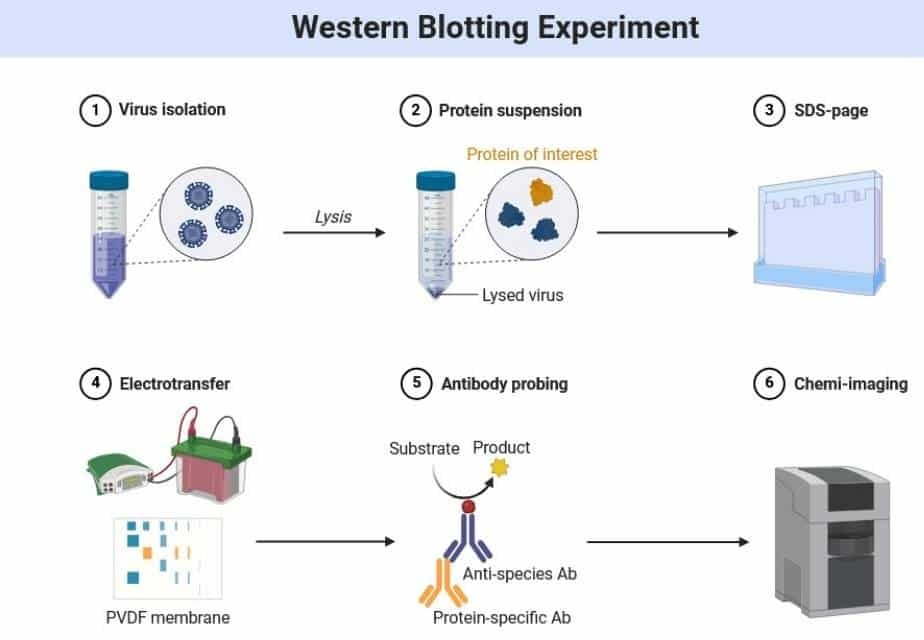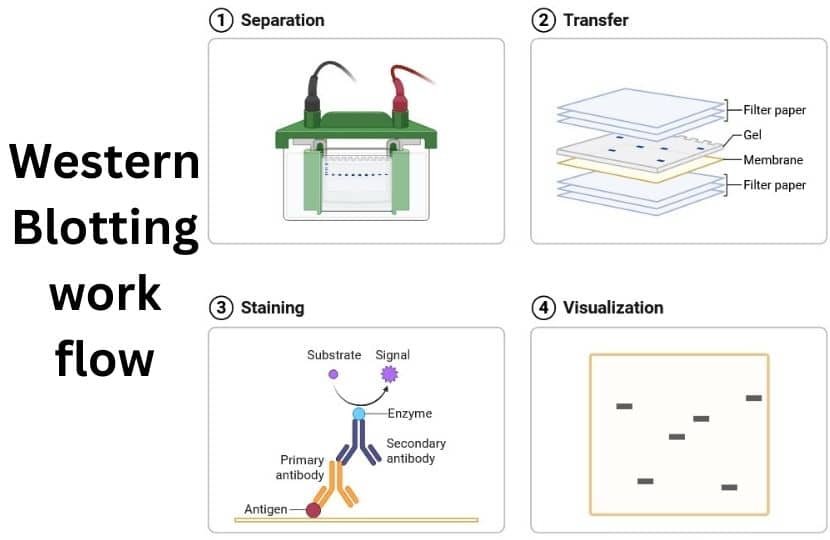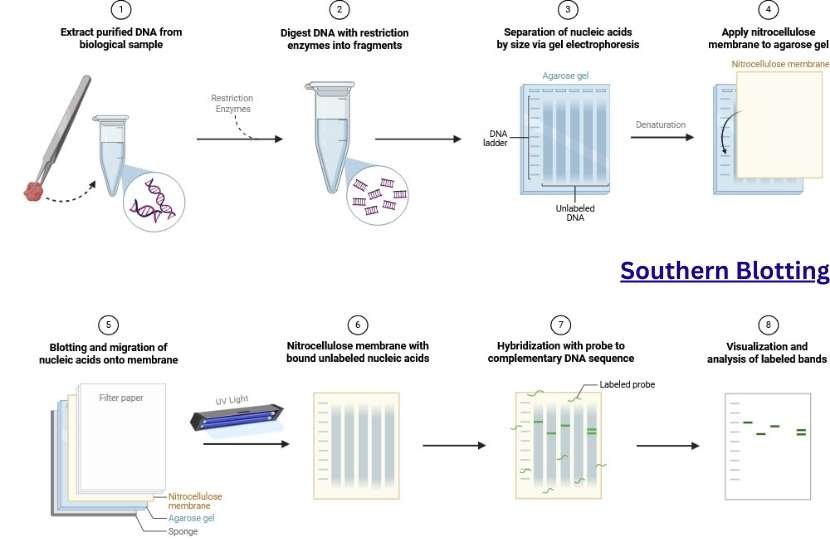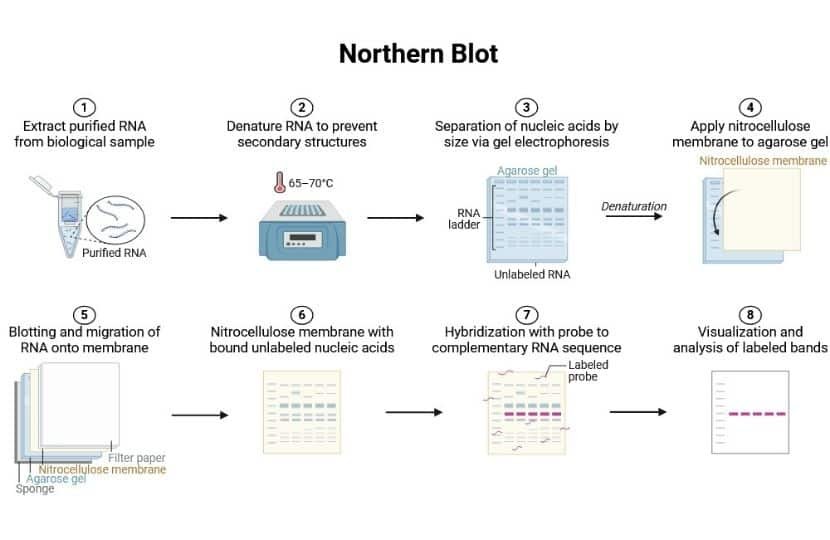Table of Contents
ToggleIntroduction
- In molecular biology and biochemistry, molecular blotting is a fundamental laboratory method used to detect and analyze biological macromolecules such as DNA, RNA, and proteins.
- The technique involves separating these molecules through electrophoresis and transferring them from a gel matrix onto a solid support membrane (commonly nitrocellulose or nylon).
- Once immobilized, they can be probed, detected, and visualized with high specificity and sensitivity.
- Blotting has revolutionized biological research, offering precise ways to study gene expression, protein functions, genetic disorders, and infectious diseases.
- Over the years, several types of blotting techniques—Southern blotting, Northern blotting, Western blotting, and their variants—have been developed, each tailored for specific biomolecules.
- This article explores the principle, history, procedures, applications, and significance of blotting techniques in modern science, biotechnology, medicine, and diagnostics.
Principle of Molecular Blotting
Blotting is based on four essential steps:
- Separation: Molecules such as DNA, RNA, or proteins are separated using agarose gel electrophoresis (for nucleic acids) or polyacrylamide gel electrophoresis (PAGE) (for proteins). Separation occurs according to molecular size, charge, or conformation.
- Transfer: The separated molecules are blotted from the gel to a durable support membrane (nitrocellulose or nylon). This step maintains the spatial arrangement of the biomolecules.
- Detection: Immobilized molecules are probed with specific markers such as radioactive probes, fluorescent probes, or enzyme-linked antibodies, ensuring high specificity.
- Visualization: Signals are detected using methods like autoradiography, chemiluminescence, or colorimetric detection, allowing researchers to analyze the results.
Historical Development of Blotting Techniques
The evolution of blotting techniques highlights their importance in advancing molecular biology:
- 1975 – Southern Blotting
Invented by Edwin M. Southern, this was the first blotting method, designed to detect DNA sequences. - 1977 – Northern Blotting
Adapted by James Alwine, David Kemp, and George Stark, Northern blotting was introduced to detect RNA sequences. - 1979 – Western Blotting
Developed by Towbin, Staehelin, and Gordon, Western blotting allowed the detection of proteins using specific antibodies. - 1980s – Eastern and South-Western Blots
- Eastern blotting: Used to detect protein modifications such as glycosylation.
- South-western blotting: Used to identify DNA-binding proteins.
These innovations paved the way for advanced molecular diagnostics and biotechnology applications.
Purpose and Importance of Blotting
- Transfer and Detection: Biological molecules that have been separated in a gel (such as an agarose or polyacrylamide gel) are transferred to a membrane surface via blotting. The molecules are now available for more research because of this transfer, which allows them to be fixed on the membrane.
- Selective Detection: Researchers may use blotting to selectively identify and picture particular molecules of interest in a complicated mixture. Western blotting, for example, can be used to identify proteins, Northern blotting can be used to identify RNA sequences, and Southern blotting can be used to identify certain DNA sequences.
- Analysis of Gene Expression: Blotting methods are essential for researching gene expression patterns. For instance, northern blotting may be used to assess the presence and amount of particular mRNAs, which shed light on gene transcription and regulation.
- Protein Identification: Western blotting is commonly used to identify and quantify certain proteins in biological samples. It has applications in a variety of disciplines, such immunology and cancer therapy.
- Clinical Diagnostics: Blotting methods are used in clinical laboratories to identify genetic illnesses, infectious diseases, and some malignancies. For instance, the presence of pathogens can be confirmed by blotting to identify viral DNA or RNA.
- Research Applications: Blotting is a crucial method used in biochemical and molecular biological studies. It helps in deciphering molecular disease processes, examining genetic diversity, and analyzing protein activities.
- Quality Assurance: In sectors like biotechnology and pharmaceuticals, blotting is employed as a quality control method to verify the identity and purity of biological products.
- Forensic Analysis: The use of DNA blotting, notably Southern blotting, in forensic science has been used to analyze DNA evidence and determine connections between people and crime sites.
Major Types of Blotting Techniques
- Western Blotting (Protein Blotting)
- Southern Blotting (DNA Blotting)
- Northern Blotting (RNA Blotting)
Western Blotting (Protein Blotting)
The protein of interest can be qualitative or semi-quantitative using Western blotting. It’s a crucial method used in cell and molecular biology. Researchers may utilize it to ascertain the size and quantity of a given protein from a mixture of proteins obtained from cells, as well as its identity. Western blotting requires the SDS PAGE approach.

Principle
- Proteins are separated using SDS-PAGE (sodium dodecyl sulfate-polyacrylamide gel electrophoresis).
- They are transferred to PVDF or nitrocellulose membranes.
- Specific primary antibodies bind the target protein.
- Secondary enzyme-linked antibodies (e.g., HRP-conjugated) amplify detection.
- Visualization is achieved using chemiluminescence, autoradiography, or colorimetric methods.
Procedure
- A sample can be tested for the presence of certain proteins using western blotting.
- First, proteins are extracted from cells or tissues, denatured, and sorted by size using SDSPAGE.
- Following that, the segregated proteins are moved to a nitrocellulose or PVDF membrane.
- To prevent nonspecific binding, the membrane is first blocked with a protein solution (milk or BSA), then incubated with a primary antibody that specifically binds the target protein, and finally incubated with a secondary antibody that recognizes the primary antibody and is coupled to an enzyme such as HRP.
- Excess antibodies are washed away, a detection reagent such as ECL is applied, and the protein bands are seen on a chemiluminescence imager or film.

Applications
- The most accurate and sensitive method for identifying the quantity and size of protein in any substance.
- The confirmatory HIV test uses a western blot to identify antiHIV antibodies in a sample of human serum.
- The Western blot is the definitive test for Creutzfeldt-Jakob disease, Lyme disease, hepatitis B infection, and HSV2 (herpes type 2) infection.
Southern Blotting (DNA Blotting)
- In order to locate target DNA sequences in a sample, Southern blotting is a molecular approach.
- The process involves several steps, starting with the electrophoresis of DNA, the transfer of DNA pieces into nitrocellulose strip, and the exposure of these pieces to a DNA probe that has been tagged with a radioactive or chemical marker.
- The method of Southern blotting was named after Edwin Southern, who first described it in 1975.
Principle
- Electrophoresis is used to separate the tiny pieces of target DNA produced by restriction endonucleases.
- After separation, the double-stranded DNA fragments are denatured into single strands within the gel, then moved from the gel onto a blotting membrane.
- Then, a little fragment of DNA or RNA known as a probe, which has a sequence that complements the target DNA, is used to treat the membrane.
- The probe is also labelled with a fluorescent dye or radioactive atom, which allows for the identification of the desired DNA fragment from among the many DNA fragments on the membrane after hybridization.

Procedure
- DNA sequences are identified using Southern blotting.
- First, DNA is isolated, broken up into pieces using restriction enzymes, and sorted by size using agarose gel electrophoresis.
- The DNA in the gel is then denatured into single strands and moved onto a nitrocellulose or nylon membrane.
- A labelled DNA probe that binds (hybridizes) to the target sequence is used to incubate the membrane.
- To see the particular DNA bands that are bound, the unbound probe is first washed off, then autoradiography or chemiluminescence is used to detect the bound DNA.
Applications
- This trait is used to diagnose new-born and hereditary disorders, as well as to investigate mutation and gene rearrangement.
- Recombinant DNA technology, paternity and maternity analysis, forensic research, and individual identification in phylogenetic research.
- In order to show whether or not a particular target sequence exists in DNA, to ascertain if there has been chromosomal integration,
- Southern blotting allows for the analysis of the clonal rearrangements of the immunoglobulin’s, as well as the T cell receptor genes, in immunology.
- To investigate a gene’s structure or to create maps of restriction enzymes.
Northern Blotting (RNA Blotting)
The method known as northern blotting (RNA blotting) is used in molecular biology research to examine gene expression by identifying RNA or isolated mRNA in a sample. It’s a standard approach for determining the size and steady-state concentration of a particular RNA in a complex sample.
Principle
- RNA is extracted and separated by denaturing agarose gel electrophoresis.
- RNA is transferred to a membrane and hybridized with a labelled complementary DNA/RNA probe.
- Detection is achieved via autoradiography or chemiluminescence.

Procedure
- Certain RNA molecules are identified using northern blotting.
- To avoid secondary structures, RNA is first extracted and sorted by size using agarose gel electrophoresis under denaturing conditions.
- The RNA is then put on a nylon or nitrocellulose membrane.
- Hybridization is made possible by the addition of a marked DNA or RNA probe that is complementary to the target RNA.
- The target RNA is visualized by autoradiography or chemiluminescence after the excess probe has been washed away.
Applications
- The standard for researching and analyzing gene expression design across tissues, organs, developmental stages, pathogen infection, and throughout therapy.
- Diagnosis of a number of illnesses, such as viral infections and Crohn’s disease.
- Cancerous cells display an overexpression of oncogenes and a down regulation of tumor suppressor genes.
- RNA degradation and splicing study.
- Identify the precise molecular weights and composition of mRNA in a sample.
- To shield recombinants, determine the mRNA generated by the transgene.
Other Variants of Blotting
- Eastern Blotting– Detects post-translational modifications such as glycosylation, phosphorylation, or lipidation.
- South-Western Blotting– Identifies DNA-binding proteins, combining elements of both Southern and Western blotting.
- Far-Western Blotting– Detects protein–protein interactions using labelled proteins as probes.
Applications of Blotting Techniques
Blotting methods have broad applications across multiple disciplines:
- Molecular Biology Research– Studying DNA, RNA, and proteins.
- Medical Diagnostics– Confirmatory tests for HIV, hepatitis, Lyme disease, genetic disorders.
- Forensic Science– DNA fingerprinting and paternity testing.
- Cancer Research– Identifying oncogene expression and biomarkers.
- Pharmaceutical Industry– Protein validation and drug testing.
- Immunology– Studying immune receptors and antibody responses.
- Biotechnology– Ensuring purity and identity of recombinant proteins.
Conclusion
Molecular blotting remains a cornerstone of molecular biology and diagnostics, offering unmatched precision in detecting DNA, RNA, and proteins. Southern blotting, Northern blotting, and Western blotting are the classic techniques, while advanced methods such as Eastern and South-Western blotting expand their scope to post-translational modifications and protein–DNA interactions.
From gene expression studies and clinical diagnostics to forensic investigations and quality control in biotechnology, blotting techniques continue to drive breakthroughs in science and medicine. Their versatility, specificity, and reliability make them indispensable tools in both research and applied biosciences.
Also Read
- Mycorrhiza: Structure, Types, and Role in Plant Growth
- Rhizobium: The Nitrogen-Fixing Bacterium
- Bacillus subtilis– Morphology, Habitat, Diseases & Industrial Applications
- Basics of Food Microbiology in
- Top 10 Universities in India for Microbiology
- Spirulina: The Superfood Microalga with Limitless Potential
- Antimicrobial Resistance (AMR) Mechanisms and Alternatives
- Ribonucleic acid (RNA): Types, Structure & their Function
- Biochar: Properties, Production, and Applications
- Immunology Quiz
- Bacteriology Quiz
- Microbiology Notes
Reference and Sources
FAQs on Molecular Blotting Techniques
Q1. What is molecular blotting in biology?
Molecular blotting is a technique used to separate and transfer biological molecules such as DNA, RNA, or proteins from a gel onto a membrane. Once immobilized, they can be detected using probes or antibodies, allowing researchers to study their identity, size, and quantity.
Q2. What is the difference between Southern, Northern, and Western blotting?
Each blotting technique is specialized for a specific type of biological molecule.
Southern blotting detects DNA sequences.
Northern blotting detects RNA sequences, especially mRNA, to study gene expression.
Western blotting detects proteins using antibodies.
Q3. Why is blotting important in molecular biology?
Blotting allows scientists to:
Study gene expression patterns.
Identify specific proteins in complex mixtures.
Diagnose genetic and infectious diseases.
Support forensic analysis and biotechnology quality control.
Q4. Which blotting technique is used in HIV testing?
Western blotting is used as a confirmatory test for HIV. It detects anti-HIV antibodies in patient serum, making it one of the most reliable diagnostic methods.
Q5. How does Southern blotting help in forensic science?
Southern blotting can be used for DNA fingerprinting, which is crucial in criminal investigations, paternity testing, and genetic identification.
Q6. What are the advantages of blotting techniques?
High specificity (probe/antibody-based detection).
Ability to analyze complex mixtures.
Widely applicable in research, medicine, and forensics.
Provides qualitative and semi-quantitative data.
Q7. What are the limitations of blotting methods?
Time-consuming compared to modern PCR and sequencing methods.
Requires radioactive/chemical probes, which may pose safety risks.
Lower sensitivity compared to newer real-time molecular techniques.
Q8. What is the difference between Eastern and Western blotting?
Western blotting detects proteins using antibodies.
Eastern blotting detects protein modifications such as glycosylation, phosphorylation, and lipidation.
Q9. Which blotting method is best for studying gene expression?
Northern blotting is the classical method for analyzing mRNA expression levels, although modern techniques like qRT-PCR and RNA-Seq are also widely used today.
Q10. Is blotting still used in modern laboratories?
Yes, despite the rise of next-generation sequencing (NGS) and real-time PCR, blotting techniques remain essential in:
Confirmatory testing (e.g., HIV, hepatitis).
Protein analysis in research and drug development.
Teaching and training in molecular biology labs.

